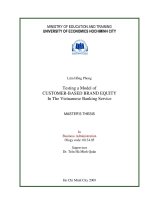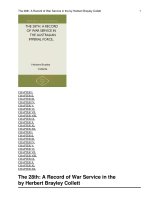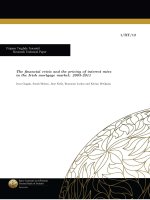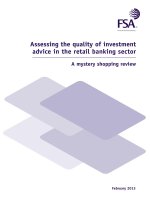A model of customer loyalty in the retail banking market
Bạn đang xem bản rút gọn của tài liệu. Xem và tải ngay bản đầy đủ của tài liệu tại đây (359.49 KB, 6 trang )
Accounting 3 (2017) 95–100
Contents lists available at GrowingScience
Accounting
homepage: www.GrowingScience.com/ac/ac.html
A model of customer loyalty in the retail banking market
Hadi Hajiyana*, Ali Akbar Aminbeidokhtib and Hadi Hemmatiana
a
b
Department of Management, Islamic Azad University, Semnan Branch, Semnan, Iran
Department of Management, University of Semnan, Semnan, Iran
CHRONICLE
Article history:
Received December 5, 2015
Received in revised format
February 16 2016
Accepted August 14 2016
Available online
August 15 2016
Keywords:
Customer loyalty
Banking industry
Quality of services
ABSTRACT
During the past two decades, there has been growing trend in Iranian banking industry due to
change in banking regulations. Private sector has grown rapidly and there have been several
new banks on the market, which has created very competitive market. Therefore, customer
loyalty is the key factor for running a successful banking business and customer relationship
management (CRM) appears to be important for the success in this industry. The primary
objective of this paper is to investigate the relationship between CRM and customer loyalty in
one of the oldest Iranian banks named Bank Melli Iran. The proposed study prepares a
questionnaire in Likert scale and distributes it among some regular customers of this bank. The
preliminary results of this survey have indicated that consumer’s gender, age and educational
background had no meaningful impact on quality of services. In other words, people with
different personal characteristics expect the same quality of services from banking industry and
there is a positive and meaningful relationship between quality of services and customer
loyalty.
© 2017 Growing Science Ltd. All rights reserved.
1. Introduction
During the past two decades, there has been growing trend in Iranian banking industry due to change
in banking regulations. Private sector has grown rapidly and there have been several new banks on the
market, which has created very competitive market. Therefore, customer loyalty is the key factor for
running a successful banking business and customer relationship management (CRM) (Ebrahimi et al.,
2016) appears to be important for having successful banking operations. In fact, customer satisfaction
is one of the primary components of modern marketing. Most businesses may only survive as long as
they are to meet the customers’ requirements. Thus, it is extremely essential in today’s intensively
competitive environment to be in regular contact with the customers. Banking industry is one of the
sectors in which competition is experienced intensively and they are the finance institutions that meet
the economic requirements of the individuals and businesses and that execute economic activities by
collecting bank deposits, granting credits, generating capital, etc. During the past few years, there have
been important developments to understand modern banking. With the transition to automation,
* Corresponding author. Tel: +989128310675
E-mail address: (H. Hajiyan)
© 2017 Growing Science Ltd. All rights reserved.
doi: 10.5267/j.ac.2016.8.002
96
customer satisfaction and management of customer relationships have been among the subjects of
studies in the banking sector. There are literally many studies on different types of CRM. Sivaraks et
al. (2011), for instance, performed an investigation on the outcomes of electronic CRM (e-CRM)
system implementation in the Thai banking industry from customers' perspectives. Since many e-CRM
implementations are not seen directly by customers, the authors performed interviews with some
experts in the Thai banking industry to develop a new framework called ‘customer-based service
attributes’ to compute e-CRM outcomes from customers' perspectives. They reported that e-CRM
implementation had a statistically significant positive relationship with customer-based service
attributes and with the quality and outcome of customer–bank relationships.
Wal-Mart is considered a benchmark of a firm that uses a blend of high-tech solutions and high-touch
employees-like flesh-and blood greeters-to increase customer loyalty. Wal-Mart allows technology
work behind the scenes by using one of the biggest CRM data warehouse in the world, which helps
track what the customers purchase precisely. Therefore, WalMart stocks more of the most popular
goods, and clusters items that customers more likely to buy at the same time. But Wal-Mart does not
implement the technology to keep individual customers’ profile and leaves that job to its local staff,
who are more familiar with their regular customers and understand their requirements (Rigby et al.,
2003). In other words, CRM software may increase customer loyalty in different ways such as tracking
customer defection and retention levels and telling us how satisfied customers are but in the end,
technology is not obviously the answer. In fact, the prime driver of customer loyalty is the loyalty of
the firm's employees (Rigby et al., 2003).
Zineldin (2006) provided a better insight of triangle relationship between quality, CRM and customer
loyalty (CL) which might lead to companies' competitiveness (CC). They designed a model (5Qs) to
measure satisfaction and loyalty based on two conditions of the customer database and CRM strategy
and that management control systems have the capacity to produce needed data for the analysis. They
reported that changing in quality over time within different segments or associated with specific
products or categories of products/services could be implemented as an indicator the level of loyalty.
Bhat and Darzi (2016) developed an integrated framework to explain the effect of CRM dimensions
(complaint resolution, customer knowledge, customer empowerment and customer orientation) on
customer loyalty and competitive advantage of a bank. They also explored the mediating role of
customer loyalty in the relationship between CRM and competitive advantage in retail banking. They
reported that the four CRM dimensions had a positive impact on customer loyalty and competitive
advantage of the bank and customer knowledge was the most influential of all the dimensions among
CRM components.
According to Abesy and Torkan (2016), technology has led most firms to offer their products and
services with higher quality and reduced prices to their loyal customers. Therefore, with the sole use of
the advanced technology or cheaper price in comparison to the competitors the competitive advantage
may not necessarily be reached and a customer is the only reliable competitive advantage for the firms.
Osayawe Ehigie (2006) performed a survey to explore customers' expectations from bank services on
the basis of which measurement scales were developed among employees of Nigerian bank including
operators of savings, current, and electronic bank accounts. He reported that perception of service
quality and satisfaction were substantial predictors of customer loyalty, with customer satisfaction
contributing more. Caruana (2002) reported that customer satisfaction play a mediating role in the
impact of service quality on service loyalty. Newman (2001) presented a case study of a pioneering
nationwide implementation of SERVQUAL (Parasuraman et al., 1988) by a major UK high street bank
over the period 1993-1997 at an annual cost of one million pounds. They reported that customer loyalty
could contribute significantly on the success of banking operations.
97
H. Hajiyan et al. / Accounting 3 (2017)
2. The proposed study
The primary objective of this paper is to investigate the relationship between CRM and customer loyalty
in one of the oldest Iranian banks named Bank Melli Iran. The study designs a questionnaire in Likert
scale with 30 questions and distributes it among some customers, randomly who do their banking
business activities with Bank Melli Iran in city of Semnan, Iran. Since the population of this survey is
unlimited we use the following to measure the sample size,
N Z 2 / 2
pq
,
e2
(1)
where N is the sample size, p 1 q is the probability, z / 2 denotes CDF of normal distribution and
finally represents the error term. For the proposed study of this paper we assume p 0.5, z / 2 1.96
and e=0.05, the number of sample size is calculated as N=59. We distribute 65 questionnaires to make
sure we reach the desirable accuracy. Fig. 1 shows personal characteristics of the participants.
12%
2%
20%
3% 9%
18%
31%
15%
11%
32%
59%
88%
Female
Gender
Male
21-28
29-36
43-50
50<
37-42
12>
Age
12
14
16
18<
Education
Fig. 1. Personal characteristics of the participants
As we can see from the results of Fig. 1, 88% of the respondents in our survey were male, 77 % had no
university education and 80% of them aged at least 28 years old. Moreover, Kolmogorov-Smirnov test
has confirmed that the questionnaire data were normally distributed. Our study examine two hypotheses
where the first hypothesis tests whether people with different personal characteristics had various
expectations from their banks in terms of quality of services and the second hypothesis investigates
whether there is any relationship between CRM and quality of services.
3. The results
The first part of the survey examines the relationship between customer’s personal characteristics and
quality of services.
3.1. The relationship between personal characteristics and quality of services as well as loyalty
3.1.1 The impact of gender on quality of services and loyalty
In this study, we use Levene’s test and t-test to examine the effects of gender on quality of services and
customer loyalty. Table 1 shows the results of the survey.
98
Table 1
The summary of Levene’s test and t-test on the effects of gender on quality of services and loyalty
Quality of services
Customer loyalty
H0:σ12 = σ22
H1:σ12 ≠ σ22
H0:σ12 = σ22
H1:σ12 ≠ σ22
Levene’s test
F
Sig.
1.452
0.233
0.025
t
0.082
0.064
-1.205
0.875
t-test
df
63
8.081
63
9.132
Sig.
0.935
0.950
0.233
0.255
Based on the results of Table 1, gender shows no meaningful effect on quality of services and loyalty.
3.1.2. The impact of age on quality of services and loyalty
The proposed study of this paper implements ANOVA test to measure the effect of age on participants’
personal characteristics on quality of services as well as customer loyalty and Table 2 demonstrates the
results of the survey.
Table 2
The summary of ANOVA test on the effects of age on quality of services and loyalty
Quality of services
Customer loyalty
Between group
Within group
Total
Between group
Within group
Total
Sum of Squares
233.235
6489.227
6722.462
490.010
4856.236
5346.246
df
4
60
64
4
60
64
Mean Square
58.309
108.154
F
0.539
Sig.
0.708
122.502
80.937
1.514
0.210
As we can see from the results of Table 2, age maintains no meaningful effect on quality of services
and loyalty.
3.1.3. The impacts of education on quality of services and loyalty
Again, the survey uses ANOVA to examine the effect of education on quality of services and customer
loyalty and Table 3 shows the results of the survey.
Table 3
The results of ANOVA test on the effects of educational background on quality of services and loyalty
Quality of services
Customer loyalty
Between group
Within group
Total
Between group
Within group
Total
Sum of Squares
758.150
5964.311
6722.462
843.994
4502.252
5346.246
df
4
60
64
4
60
64
Mean Square
189.538
99.405
F
1.907
Sig.
0.121
210.999
75.038
2.812
0.033
According to the results of Table 3, customer’s educational background has no meaningful effect on
quality of services. However, it has some impact on customer loyalty when the level of significance is
5%.
3.2 Main hypotheses
In this survey, we investigate the impacts of CRM on quality of services and customer loyalty,
1. There is a meaningful relationship between CRM and quality of services.
2. There is a meaningful relationship between CRM and customer loyalty.
99
H. Hajiyan et al. / Accounting 3 (2017)
3.2.1 First hypothesis: The effect of CRM on quality of services
The first main hypothesis of the survey tests the relationship between CRM and quality of services.
Table 4 presents the results of one-way test.
Table 4
The results of one-way test on relationship between CRM and quality of services.
Quality of services
t-value
10.105
df
64
Sig.
0.000
Mean difference
85.641
95% confidence interval
0.6871
1.0257
Based on the results of Table 4, CRM has shown a meaningful effect on quality of services (α = 5%).
Therefore, the first hypothesis of the survey has been confirmed.
3.2.2 Second hypothesis: The relationship between CRM and customer loyalty
The second hypothesis of the survey examines the relationship between CRM and customer loyalty.
Table 5 presents the results of one-way test.
Table 5
The results of one-way test on relationship between CRM and customer loyalty
Quality of services
t-value
11.915
df
64
Sig.
0.000
Mean difference
0.90051
95% confidence interval
0.7495
1.0515
Based on the results of Table 5, there is a meaningful relationship between CRM and customer loyalty
(α = 1%). Therefore, the second hypothesis of the survey has been confirmed.
4. Conclusion
We have presented a survey to examine the relationship between customer’s personal characteristics
and service quality expectations. Using an empirical investigation, the study has determined that people
with different age, gender and educational background maintained similar expectations from their
banks. The study has also confirmed that there was a positive and meaningful relationship between
CRM and customer loyalty. Our more in-depth survey has indicated that e-business facilities
contributed significantly on customer loyalty and this consistent with findings reported by Lee-Kelley
et al. (2003) and Liu et al. (2012). These days, many businesses such as banks, insurance firms, and
other service providers have understood the relative importance of CRM and its potential to acquire
new customers, retaining existing ones and maximize their lifetime value through providing need based
services in the changing economic scenario (Kishor & Nagamani, 2015). The results of this survey
have emphasized that banking industry could be more successful only by providing comprehensive
CRM and dedicated employees who serve their customers well.
Acknowledgement
The authors would like to thank the anonymous referees for constructive comments on earlier version
of this paper.
References
Abesy, S., & Torkan, V. (2016). Planning customer relationship management (CRM) strategies in the
mining and industry bank. Mediterranean Journal of Social Sciences, 7(3 S3), 298.
Bhat, S. A., & Darzi, M. A. (2016). Customer relationship management: An approach to competitive
advantage in the banking sector by exploring the mediational role of loyalty. International Journal
of Bank Marketing, 34(3), 388-410.
Caruana, A. (2002). Service loyalty: The effects of service quality and the mediating role of customer
satisfaction. European journal of marketing,36(7/8), 811-828.
100
Ebrahimi, E., Fathi, M. R., & Irani, H. R. (2016). A new hybrid method based on fuzzy Shannon's
Entropy and fuzzy COPRAS for CRM performance evaluation (Case: Mellat Bank). Iranian Journal
of Management Studies,9(2), 333.
Kishor, N. R., & Nagamani, K. (2015). Customer relationship management in Indian Banking
Sector. ACADEMICIA: An International Multidisciplinary Research Journal, 5(7), 74-82.
Lee-Kelley, L., Gilbert, D., & Mannicom, R. (2003). How e-CRM can enhance customer
loyalty. Marketing Intelligence & Planning, 21(4), 239-248.
Liu, C. C., Tseng, H. C., Chuang, L. M., & Huang, C. M. (2012). A study of the impact of the E-CRM
perspective on customer satisfaction and customer loyalty-exemplified by bank Sinopac. Journal of
Economics and Behavioral Studies, 4(8), 467.
Newman, K. (2001). Interrogating SERVQUAL: a critical assessment of service quality measurement
in a high street retail bank. International Journal of Bank Marketing, 19(3), 126-139.
Osayawe Ehigie, B. (2006). Correlates of customer loyalty to their bank: a case study in
Nigeria. International Journal of Bank Marketing, 24(7), 494-508.
Parasuraman, A., Zeithaml, V. A., & Berry, L. L. (1988). Servqual. Journal of retailing, 64(1), 12-40.
Rigby, D. K., Reichheld, F., & Dawson, C. (2003). Winning customer loyalty is the key to a winning
CRM strategy. Ivey business journal, 67(4), 1.
Sivaraks, P., Krairit, D., & Tang, J. C. (2011). Effects of e-CRM on customer–bank relationship quality
and outcomes: The case of Thailand.The Journal of High Technology Management Research, 22(2),
141-157.
Zineldin, M. (2006). The royalty of loyalty: CRM, quality and retention.Journal of Consumer
Marketing, 23(7), 430-437.









